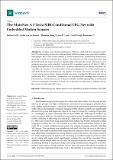The MotoNet: A 3 Tesla MRI-Conditional EEG Net with Embedded Motion Sensors
Author(s)
Levitt, Joshua; van der Kouwe, André; Jeong, Hongbae; Lewis, Laura D.; Bonmassar, Giorgio
Downloadsensors-23-03539.pdf (3.260Mb)
Publisher with Creative Commons License
Publisher with Creative Commons License
Creative Commons Attribution
Terms of use
Metadata
Show full item recordAbstract
We introduce a new electroencephalogram (EEG) net, which will allow clinicians to monitor EEG while tracking head motion. Motion during MRI limits patient scans, especially of children with epilepsy. EEG is also severely affected by motion-induced noise, predominantly ballistocardiogram (BCG) noise due to the heartbeat. Methods: The MotoNet was built using polymer thick film (PTF) EEG leads and motion sensors on opposite sides in the same flex circuit. EEG/motion measurements were made with a standard commercial EEG acquisition system in a 3 Tesla (T) MRI. A Kalman filtering-based BCG correction tool was used to clean the EEG in healthy volunteers. Results: MRI safety studies in 3 T confirmed the maximum heating below 1 °C. Using an MRI sequence with spatial localization gradients only, the position of the head was linearly correlated with the average motion sensor output. Kalman filtering was shown to reduce the BCG noise and recover artifact-clean EEG. Conclusions: The MotoNet is an innovative EEG net design that co-locates 32 EEG electrodes with 32 motion sensors to improve both EEG and MRI signal quality. In combination with custom gradients, the position of the net can, in principle, be determined. In addition, the motion sensors can help reduce BCG noise.
Date issued
2023-03-28Department
Massachusetts Institute of Technology. Institute for Medical Engineering & Science; Massachusetts Institute of Technology. Department of Electrical Engineering and Computer SciencePublisher
Multidisciplinary Digital Publishing Institute
Citation
Sensors 23 (7): 3539 (2023)
Version: Final published version